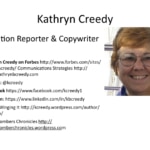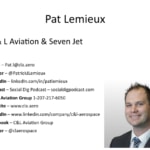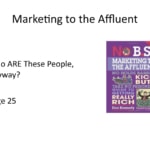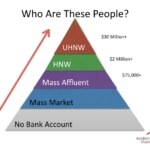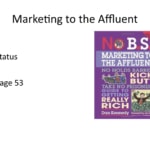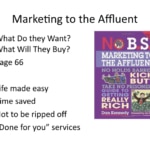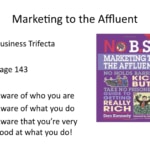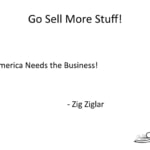Marketing to the Affluent can be intimidating to those of us who didn’t come from an affluent background. Kathryn Creedy, Lillian Tamm, Pat Lemieux, John Williams and I go over some of the misconceptions about marketing to the affluent, and some our experiences of reaching to to and working with this misunderstood demographic.
Transcript – Marketing to the Affluent by Dan S Kennedy
[MUSIC] Announcer: You’re listening to Aviation Marketing Hangar Flying. The aviation podcast community for the best sales and marketing professionals in the aviation industry. You can’t learn to fly just from a book. You learn from other pilots who know the tools, the skills and the territory. Your hosts, John and Paula Williams, are your sales and marketing test pilots.
Announcer: You’re listening to Aviation Marketing Hangar Flying. The aviation podcast community for the best sales and marketing professionals in the aviation industry. You can’t learn to fly just from a book. You learn from other pilots who know the tools, the skills and the territory. Your hosts, John and Paula Williams, are your sales and marketing test pilots.
They take the risks for you and share strategies, relevant examples, HECs, and how to’s. Be sure to subscribe on iTunes so you won’t miss a thing.
Paula Williams: We’re staying up later and getting up later. [LAUGH] Because we’re getting into the holidays and having people in from out of town and things like that. So yeah, today we’re talking about Dan Kennedy’s Marketing to the Affluent. And we have some really fantastic people on the line with us which is wonderful.
And if we could just kind of go around the table and have everybody introduce themselves. I’m Paula Williams, and John Williams. Which our mission is to, what is our mission John [LAUGH]?
John Williams: Help everybody sell more stuff in the aviation world.
Paula Williams: Absolutely, exactly. And Kathryn, if you could go next?
Kathryn Creedy: I’m Kathryn Creedy with Communications Strategies. I am an aviation journalist as well as a public relations specialist, and trying to help companies get in the media spotlight.
Paula Williams: Fantastic. And Lillian’s here also.
Lillian Tamm: I’m an aviation business evaluator. I evaluate aviation businesses and provide consulting services related to evaluations.
Also other general aviation industry consulting, like business plans and visibility studies, and things along those lines.
 Paula Williams: Fantastic. And Pat, good to have you join us.
Paula Williams: Fantastic. And Pat, good to have you join us.
Pat Lemieux: Hi, how are you?
Paula Williams: [LAUGH] Great.
Pat Lemieux: Good, sorry I’m just kind of coming on late here. Pat Lemieux with C&L Aviation Group.
I’m our director of marketing so I’m in charge of handling the growth of our name recognition in the marketplace. And from that obviously, the amount of work that we do for CL Aviation Group and our sister company, Seven Jet Private Travel.
Paula Williams: Fantastic. Yeah, I was just commenting on your Instagram this morning with the last, lonely office doughnut.
Pat Lemieux: It went so fast
Paula Williams: Did you rescue it?
Pat Lemieux: No, no.
Paula Williams: No?
Pat Lemieux: I left it right there for somebody else.
Paula Williams: Okay [LAUGH] cool, well that’s good to know.
Well we’re really glad that you’re here, and we’ve got a lot to talk about today. And I know you three, actually, if I were to pick three people who know a lot about this particular topic, this is actually really cool because I know you guys all have affluent customers and are looking for affluent customers as well.
So really looking forward to your insights. So first thing, who are these people anyway? We can kind of go around the room and, once again we’re going to edit this. So [LAUGH] if there’s anything that you’d want us to edit, just let us know and we’ll take it out.
But yeah, let’s start with Kathryn and go down the list, in order of appearance.
Kathryn Creedy: Well, marketing to affluent people is extremely important since you have to be affluent to get into this business. Or rather to be a customer for aviation. I would like, I’m trying to get into the luxury travel press to see, to get a better hook on marketing to the affluent.
I did a trip this year that was geared toward the affluent with really, really over the top luxury accommodations in China. And I was absolutely blown away and got some good copy out of it. But I’d like to get more of an idea about how to market to the affluent and how to write about affluent consumers, and that’s why I’m here.
Paula Williams: Fantastic. Yeah, I know. I really enjoyed watching your Facebook feed and all your pictures and things like that as you were going through that. That was exciting.
Kathryn Creedy: Yeah.
Paula Williams: Cool. And Lilian, I know you have, well your clientele is mainly people who are buying and selling aviation companies, or getting valuations of them, so by definition this is your wheelhouse, right?
Lillian Tamm: Well it is to some extent. A lot of my businesses sell to affluent clientele. So for me understanding how they approach it is something that is probably a bigger benefit. I have a lot of CFOs and senior managers and then owners of businesses that are my clients.
And some of them would fall into that affluent market. But selling the service that I do is not necessarily directly related to it. But it helps me understand the whole, how my market approaches the market, if you will.
Paula Williams: Yeah, your customers’ customers. Exactly.
Lillian Tamm: Right.
Paula Williams: That makes perfect sense.
Lillian Tamm: In analyzing businesses, it’s a good thing to understand.
Paula Williams: Absolutely, right. And Pat, this is your bread and butter, at least for Seven Jet.
Pat Lemieux: Right, yeah, naturally. Marketing to this group doesn’t really come natively to me, so it’s been a little tricky. I found that what’s worked the best for us here is really trying to work with our sales guys to better understand who our existing customers are.
And really try to figure out, and that goes from everything to what they’re looking at online, what they’re reading, and if they’re watching anything what it would be, where they’re vacationing, where they live, those zip codes. And really using all of that to try to target as surgically as possible with this group, and actually get in front of them.
Paula Williams: Right, exactly. I thought we would start with some misconceptions about affluent people. I think it has almost become a bad word. People have kind of politicized the whole affluence, or the 1% or the whatever they’re calling it no. So there’s some misconceptions about affluent people. I thought we might start with these, and talk about that a little bit.
John Williams: Yeah. One of my things I find irritating, let me just put it that way, is when people call me or anybody else lucky.
Paula Williams: Right.
John Williams: I believe it was either Benjamin Franklin or Abraham Lincoln found that they actually believed in luck. And they figured out that the harder they worked, the more of it they had.
Paula Williams: Right, I think, this kind of comes from, there’s kind of been a movement. When people are interviewed in the press and things like that and they are wealthy, they tend to say that they are fortunate. And I think that’s okay for them to say, but I think for us to say that about them it becomes kind of offensive.
Because a lot of these people made their money in this lifetime, they weren’t handed it, right?
John Williams: Exactly, and in fact if you read Kennedy’s book which is what we’re talking about I think out of 400 and change of them, 320 of the billionaires started from scratch.
Paula Williams: Right, so it’s not like they married into it or inherited it or anything like that.
John Williams: I can tell you, although I’m not a billionaire yet.
Paula Williams: [LAUGH]
John Williams: I aspire to that one day, and there’s no reason not to actually. But my Dad started off as a parts manager for Ford Motor Company making $25 a month.
Paula Williams: [LAUGH] Right.
John Williams: Now, that does not put me in the entitled wealthy class, by any stretch.
Paula Williams: You’re right, and I’ve been reading a lot of stories in the book. These people came from, a lot of them are immigrants. A lot of them came from very humble background and things. So anyway, that sort of segues into the entitled piece and although there are some old money people who pass it along, more and more of those who do pass it along are requiring their kids to learn how to work first and how to manage money.
So they’re giving their money to charity rather than leaving it to the kids.
John Williams: Exactly right.
Paula Williams: Feel free to jump in anywhere if you [LAUGH] would like too.
Kathryn Creedy: I have a comment. I do think that the politicization of the quote unquote elite. I find it counterproductive because it’s an us versus them type of thing.
And when you look at polls, us, we, are not begrudging them their wealth. We are not saying that they did not work for their wealth. And we want to be able to do that, so this us versus them is very counterproductive for me. But for business aviation there’s a more important point.
And this is one reason why I’m so disappointed in the industry that it has not come to the floor in, quote unquote, defending our affluent customers because business aviation is the perfect nexus between Wall Street and Main Street. They’re the ones who buy our aircraft or whatever services.
Main Street is where it’s made, and all you have to do is ask Wichita what happened in 2008, 2009, and 2010. And you see that when those people stop buying, we are the ones that really hurt. I mean, the worker bees are the ones that really end up hurting.
You know, this harkens back to the 1990s when we had a similar situation, it was us versus them. And Congress put together a luxury tax.
Paula Williams: Yeah, I remember.
Kathryn Creedy: And the only people that really got hurt in that luxury tax was people who built the yachts. So all those middle class jobs for building aircraft and building yachts went away, because nobody was buying them because they were mad at the government.
Paula Williams: Exactly.
Kathryn Creedy: So, I think that we have to remember, and whenever we’re talking to people about this, and that we see the conversation going into us versus them, we need to remember that if it weren’t for them, we wouldn’t have jobs. And they are a perfect nexus between Wall Street and Main Street because the middle class are the ones who build the machines or whatever it is or provide the services, and the rich are the consumer.
And so without them, we wouldn’t have jobs.
Paula Williams: Absolutely, and if I can jump on the soapbox for just a second, I think the problem that happened in 2008 with the people going to meet with Congress to ask for money, the big three automakers in their private jets.
The story was told from the perspective of the media which really didn’t understand aviation. And aviation didn’t have a story to tell that was polishd and ready to go at that time. We really didn’t do a very good job of telling our side of the story. And I think that’s really what drives us in this industry to start telling better stories, because if your-
Kathryn Creedy: If your having [CROSSTALK] the business aviation industry for decades. I knew the story was there. There was a narrative there that could have completely turned that situation around.
Paula Williams: Yeah.
Kathryn Creedy: Bad people had the guts to do it and I think, one, the industry didn’t have the guts, for a corporate aviation users didn’t have the guts And NBAA did not have the narrative in a story form that could say to the meaning of, well, yeah, maybe they shouldn’t have come all three in their corporate jets.
But you have to remember, this is what a corporate jet will do for this guy or this business. And this is how that business makes money. And, all the material was there. Nobody used it. It wasn’t till five or six months later that MBAA got their act together, and I was absolutely shocked.
Paula Williams: [LAUGH]
Kathryn Creedy: Knowing-
Paula Williams: No gain, right?
Kathryn Creedy: It was there.
Paula Williams: Right, took a long time.
Kathryn Creedy: Yeah.
Paula Williams: And they did. They came out with the “No Plane No Gain” initiative and got some celebrities and other people to go on the record for this is how we use our aircraft.
But it was like pulling teeth because the emphasis, I think for high net worth people is to keep a low profile. A low profile, you’re not telling your story, and what dominates the media is what everybody else is saying, right?
Kathryn Creedy: Right, absolutely.
John Williams: And the story of Mrs. Nancy Pelosi flying a private corporate jet back and forth to California.
It was actually an airliner. That didn’t come out for almost a year and a half.
Paula Williams: Right well when you do a [LAUGH] right? And I know we sometimes get political but we have to because that’s-
John Williams: Well the government is no better and no worse. They do the same thing only use bigger stuff.
Paula Williams: Right, waste is waste, but private jets are not by nature waste. You know, and that’s really the story we need to tell.
Kathryn Creedy: No.
Paula Williams: Right.
Kathryn Creedy: So I think that, what I’m saying is that as we talk to our colleagues or, you know my biggest problem with no plane no gain is it’s preaching to the choir.
It’s not really preaching beyond the choir.
Paula Williams: Right, true.
Kathryn Creedy: And I get very angry when I see an NBAA. This big sign that says I can’t do my job in New Mexico were it not for my plane. So I don’t want to hear from him. I want to hear how his business is kept there because of his plane but I don’t want to hear from him.
I want to hear from the city fathers.
Paula Williams: Yeah.
Kathryn Creedy: That’s why this airport is. So I think we’re talking past each other, but also as we’re talking to our affluent customers. We need to help them understand that we get it. That we understand that what they’re doing is not excess, that it’s a business tool to create productivity, to create the bottom line to feed the bottom line.
Paula Williams: Right.
Kathryn Creedy: So that’s so much my soapbox.
Paula Williams: [LAUGH]
John Williams: Well, we need to talk about, everybody assumes that affluent means millions or billions, and actually the bottom of the affluent pyramid starts around 75,000. [COUGH] So that covers an awful lot of people.
Paula Williams: Right.
Kathryn Creedy: But I think that it’s a mistake to look at government figures where affluence starts.
Because a lot of people make $75,000 with both people working. So they’re making $35,000 each, and that’s no way affluent nor would it be affluent-
John Williams: This book is talking about an individual that makes $75,000.
Kathryn Creedy: Well, even at $75,000, I think that when we’re talking about affluent we need to work beyond the government statistics because-
John Williams: This is not a government statistic, by the way.
Kathryn Creedy: Okay, you’re teaching me something.
Paula Williams: The real thing is that for aviation, affluence is a slightly different number than it might be for buying a weekend at the spa.
John Williams: [LAUGH] That’s right.
Paula Williams: So that’s probably we have to, for the purposes of our discussion, cuz we’re talking aviation, I think the number just needs to be at the higher, the high net worth, as opposed to just mass affluent.
Cuz mass affluent’s not the market for most corporate aviation.
John Williams: Exactly.
Paula Williams: Yeah, and most of the marketing materials, or at least most of the marketing stuff that I have seen in marketing organizations and other kinds of things are focused on the mass market, or the blue area, and possibly into the mass affluent.
But nobody really talks other than, I think this is why this book is unique and very helpful is because it’s talking about the top half of the pyramid where there really isn’t a lot of marketing data. And there’s not a lot of marketing technique and a lot of really solid information.
And so that’s one of the reasons I really like this book and may [LAUGH]. We’re not really doing it in 2017, but we probably will bring it back again in a revised form in the following years because there’s nothing else that I’ve seen that’s this good.
John Williams: Well, he talks not only about demographics, but psychographics as well.
And when you put all that together and you realize to market to these people what you have to understand about their attitudes, and not just toward airplanes, but their attitudes towards money, their attitudes toward people.
Paula Williams: Yeah.
John Williams: And their confidence, lack thereof, and so on.
Paula Williams: Another misconception, while we’re talking about that is that a lot of people kind of shy away from the high end.
And Pat, you might find this helpful information, because I felt this way when I got into this market. Feeling a little bit weird about marketing to high net worth and ultra high net worth people. But the more we work with them, the more comfortable we get because there’s the misconception that they are super picky and super snooty and super particular, and want all of the brown M&M’s picked out of the bowl.
I mean, just goofy, stupid things and there are some like that. But for the most part, our clients who are in the top two categories are, if I had to make a generalization, I would say they’re actually easier to work with.
John Williams: Yeah.
Paula Williams: And I think that’s because they’ve been in business for a while.
They are willing to tolerate a little more risk. They’re a little more creative, and have the resources to do things right. And we’re not trying to, we don’t have to make their first campaign knock it out of the park. They’re okay with a little bit of risk.
John Williams: Well, they have their needs met.
Paula Williams: Yeah.
John Williams: It’s all about wants for them.
Paula Williams: Right.
John Williams: And then well, we can get into that later, but-
Paula Williams: [LAUGH]
John Williams: Keep the going here.
Paula Williams: Exactly, true. No, I think we’re doing all right. But yeah, anybody wanna add anything else to this before we move on?
Pat Lemieux: I was just gonna say that one of things that I don’t know if it comes to mind that often is that a lot of these people, and you brought up a good point, that they don’t necessarily start rich or anything. And you don’t get rich or stay rich by making bad choices with your money.
Paula Williams: Right.
Pat Lemieux: So I think this gets often overlooked, that even the super rich are still looking for a good deal, just like somebody who makes 30 grand, or 40 grand a year’s looking for a good deal on a car. These guys, they’re looking for a deal as well.
And I think that gets overlooked a lot.
Paula Williams: Yeah.
Pat Lemieux: And it gets overlooked by trying to focus in on only the blue M&Ms and really kind of the frills. And sometimes that’s just not necessary.
John Williams: I would disagree with that approach, actually. And as an example, let’s use his example in the book.
Paula Williams: [LAUGH]
John Williams: Lamborghinis sell from $250,000 to $1.4 million.
John Williams: And guess which ones sell out first, and guess which ones there is a backlog of orders for. It’s the $1.4 million Lamborghinis. They’re not after the cheap Lamborghini, though the people want cheap Lamborghini, because they can’t really afford them.
Pat Lemieux: Is that more of a scarcity issue?
John Williams: No.
Paula Williams: Well, it’s a status issue.
Kathryn Creedy: Is it a posh issue? In other words, is it an I wanna impress my friends issue?
John Williams: That’s right.
Paula Williams: Yeah, and we actually do have a couple of slides about status.
And I think that is an excellent point. But I think as long as it’s being used for that purpose that’s one thing, but picking out the blue M&Ms or whatever, we had talked last week about the fact that a lot of people, when they market to this market they wanna make things fancier.
And you’re not marketing to Louis the XVIII, [LAUGH] you’re marketing to regular people. This is not Versailles, things get simpler as you go up the scale as opposed to fancier.
Lillian Tamm: I have to agree that the numbers make a difference for some of the ultra wealthy, because with our company, we’ve had a couple of clients who have acquired aircraft.
And they definitely look at the numbers. It’s like, okay, my budget is 40 million, but I can buy this used aircraft for X amount, and I can refurb it for X amount, and if it’s not going to fit into that box, then I’m not interested, I still have a budget.
Yeah, it may be a ridiculous budget as far as the mass market is concerned, or even the mass affluent, or even the high net worth. But when you start getting into the upper echelons, they still care.
Paula Williams: Yeah, absolutely, they do.
Lillian Tamm: Not [INAUDIBLE], that’s not how they got where they are [LAUGH] .
John Williams: It’s fun to play devil’s advocate.
Paula Williams: That’s true. All right, since we’ve already kinda broached the topic of status, what does that mean and why is that important?
John Williams: What do you mean, what does that mean?
Paula Williams: Well, I think, everybody who [CROSSTALK]
John Williams: It’s important because that’s what, and I will sayit from the male perspective.
Paula Williams: Okay [LAUGH]
John Williams: Because that’s what guys do. [LAUGH]
Paula Williams: [INAUDIBLE] I’m sure you can do that better than I can.
John Williams: Guys, and the more money you get, the more status that the majority of guys want to. There are those that wanna do it Trump style. But mostly, they wanna do it under the covers and only be status with respect to their peers.
Paula Williams: I think it’s limited. So everybody has a thing that they want to be the best at or known for. So they’re not gonna spend a ton of money on everything.
John Williams: No.
Paula Williams: But they will buy a Lamborghini, if their friends are into cars, and are gonna be impressed by that.
Is that fair?
John Williams: It appears, yes.
Paula Williams: Yeah. Absolutely. I think this is really what’s going on is nobody ever really grows up and nobody ever really gets past the whole of one upmanship of things. In fact, people get wealthy because they love the game, I think. Yeah, so these are more competitive than regular people.
John Williams: Actually, according to the book, it’s because people lack confidence. They show confidence, but they lack it in respect to their money, so they keep working hard, and making more of it, because they’re afraid it’s going to go away.
Paula Williams: I think there’s some of that, and i think some of them just love the game.
John Williams: Well this-
Paula Williams: They love being better, one upping somebody else.
Lillian Tamm: That’s very true.
John Williams: Just rolling up the score.
Paula Williams: [LAUGH] Exactly. In fact, we’ve had some clients who, and this can be used for good or evil just like everything else, we had one client who was absolutely determined that he had to beat this other guy who was a competitor, on a particular aviation keyword.
I don’t know if they’d bet each other something, or what the situation was, but it was a keyword that had very, very little impact on their marketing. But the absolutely, positively had to one up each other and it ended up being a negative situation, at least from a marketing perspective, because it didn’t really matter.
And we could spend unlimited resources on this one thing and the other person would do something the next week and we’d end up in this competitive situation that did more harm than good. But I think you can use it in a good way too. When you’re selling, you can say, here’s how you can do things better than the next guy, and I think that people respond to that really well.
John Williams: Yeah, I remember that situation.
Paula Williams: Yeah?
John Williams: That was nuts.
Paula Williams: That was nuts, but it did happen.
John Williams: Yes, of course, it did.
Paula Williams: With otherwise incredibly intelligent and otherwise, rational human beings.
John Williams: Yeah, right.
Paula Williams: Yeah. Cool. Anybody have anything to add to that or move on?
Paula Williams: What do they want? What will they buy? AThe easy answer from the book is [LAUGH], besides status, of course, which we already talked about. They want things made easy for them. They want time saved. They want not to be ripped off. I think this is a bigger deal with affluent people than it is with other folks.
They’re a little more sensitive about this cuz I think they’re big targets for a lot of shady marketing.
John Williams: That’s interesting, I don’t know if they are or not anymore than the rest of us. I don’t know that. That may not be true, especially the what do they call it, the drive by virus is out there now.
Where you just go visit the website and it encrypts your database, and your hard drive and they make you buy it out.
Paula Williams: It’s kind of a kidnapping. [LAUGH] Kidnapping your data.
John Williams: Exactly what’s it’s doing.
Paula Williams: I think there is a certain amount of skepticism. Most of them have gatekeepers of some kind and have ways of protecting themselves that the rest of us don’t.
They live in gated communities, literally and figuratively, if we wanna call it that.
John Williams: True.
Paula Williams: I think they spend more money on security. They spend more money on basically checking things out before they get involved.
John Williams: They have a lot more discretionary income, or revenues that’s for sure.
Paula Williams: So this lengthens the sales cycle. This is why it takes us, and actually our sales cycle has been getting a little bit shorter. A year ago it was at eight and a half months, I think now it’s closer to six months.
John Williams: Really?
Paula Williams: We’ve had a few people, again, our statistical pool is not huge because we aren’t mass market.
But people do check us out for a really long time before they spend a lot of money with us, which is good.
John Williams: Sure, I would.
Paula Williams: Cool, so what does this mean from a marketing perspective?
John Williams: You need to know your demographics and psychographics of your individuals.
Paula Williams: [LAUGH] Yeah, and another thing that we found is that we used to have a lot of do it yourself kind of packages. Where we would give people a lot of information and send them home with homework and meet with them the next week and give them another set of homework and those kinds of things, thinking that we could save people a lot of money.
As it turns out, this market really doesn’t care about that.
John Williams: [LAUGH] That’s right.
Paula Williams: They don’t want to. In fact, it’s really hard even doing a book club, I really, really respect you guys for being willing to spend time and energy on this. Because you are the few that recognize that getting better at sales and marketing is probably the most important skill you can develop.
But for a lot of marketing tasks, they would just as soon throw it over the wall, and have us do it and that’s why a lot of our clients you would never see in a book club discussion.
John Williams: Yep, pretty much.
Paula Williams: But most of them are in sales and marketing, so some of them you would
John Williams: All of them are in sales.
Paula Williams: Yeah, that’s true. That is absolutely true. I thought this ad from Schubach Aviation is pretty much the epitome of what we just talked about.
Kathryn Creedy: That’s nice.
Paula Williams: Yeah.
Kathryn Creedy: Simple.
Paula Williams: Yep. Simple, lots of light white space. One idea and it’s obviously, the one thing that they all want.
John Williams: Which is why you make more money so you can have more of that.
Paula Williams: Mm-hm, priceless. One hour with your kids or your grandkids or your family.
Kathryn Creedy: It resonates with everybody, no matter who they are.
Paula Williams: Yep, absolutely and I think this applies to all of us.
I mean, Pat, you’re in the time machine business.
Pat Lemieux: Right, and this is I saw a YouTube video at one point too, the company that did it is escaping me at the moment, but it was a charter company, one of the big guys. They just showed two days, side by side, one of a guy who was heading to a meeting taking charter, one of a guy who was going to that same meeting kind of messing with the airlines and doing the whole regional thing.
And that guy’s getting up earlier, he’s running late. He’s tired. He’s uncomfortable at the airports. He’s waiting in line at the airport, while the other guy whose on the private side is gonna getting out of bed and having breakfast with his family. They both actually are going to the same meeting, and the guy on the private jet is actually home in time for dinner, whereas the other guy is delayed somewhere.
It just hit that point really well in like a minute long video that, so this is exactly why you use this sort of service.
Paula Williams: Exactly. That’s great. So, he’s staying in a cold hotel while the other guy is home with his family having dinner, that’s going to really resonate with this audience. great example of marketing to the affluent.
Kathryn Creedy: Do you have a link to that?
Pat Lemieux: Actually, I just pulled up. I’m going to have to find it, because I can’t remember what it is. But I’ll find it and I’ll share it with the group.
Kathryn Creedy: That would be goof for all of our, this is business aviation ,15 minute elevator speeches.
Paula Williams: Yes, absolutely.
That’s fantastic.
Pat Lemieux: Right.
Paula Williams: Okay, so, yeah, the business trifecta, I think, is one of the things, and I actually have the page number wrong in the bookmark, so hopefully you were able to find that. But there are three things that you can do that make people aware of who you are, aware of what you do, and aware that you’re very good at what you do, and those things are media, PR, and marketing.
John Williams: What I found interesting was his comment in the book is that when you sell, when he’s talking to these guys, and actually in a sales sort of environment They are more likely to buy if you tell them your background. And a thumbnail sketch of how you got into business, how you morphed to business, how you’ve managed it.
Then you start making money, and you’re doing these other things, and your goals. Cuz they appreciate that because they’ve all done that. Right.
Paula Williams: They can connect easier with that.
John Williams: Right, we actually-
Kathryn Creedy: What’s your [INAUDIBLE] of direct media, is that advertising?
Paula Williams: Direct media is any media that you own, for example a podcast, or a book, or a website, or a newsletter, or any of that stuff And everybody should have direct media channels of some sort and the more and better they are, the better.
But getting back to John’s point, I think that is, that’s why we’re doing the storytelling summit at Sundance is because we want to focus on origin stories. And if you can tell your story really, really well, that is the most compelling thing, other than customer testimonials and things like that.
The most compelling sales material that you can generate. So if you can tell your story in a minute or less, or two minutes or less, on video, that really resonates with this audience, would you agree?
John Williams: Absolutely.
Paula Williams: Right, so that would be an example of a media, it would be a YouTube channel, or a website with a video on it.
Or even just a video that you send in the mail as a CD. All of that is direct media.
John Williams: And we figured that out by accident and this here confirms in this guy’s book that makes millions of dollars was kind of nice. [LAUGH]
Paula Williams: Yeah, so that’s true, I mean, you think about the really great companies, Elon Musk, and the SpaceX, and the Tesla car, and they all have a great origin story.
Steve Jobs building a computer in his garage, his parents’ basement, with a couple of buddies. And those origin stories are really what suck us in to a lot of these products.
John Williams: Yes, because typically those products that come like that are usually top-of-the-line quality-wise.
Paula Williams: Right, and then the PR of course is other people’s media.
You’ve heard of other people’s money [LAUGH] OPM. Other people’s media would be things like, Catherine, when you write a great press release and it gets picked up by one of the major magazines and things, and that gives you that additional credibility. So then you can put the Forbes logo on your website.
That really is something that you can’t buy,
Paula Williams: Literally. And then marketing activities are how you use both of those things, the direct media and the PR. Making sure you get them in front of the right person, at the right time, in the right format, and so on.
Paula Williams: Cool, all right, so anything else anybody wants to add? Or questions?
Paula Williams: Quick note- or disclosure – John and I are part of a Dan Kennedy networking group, so we end up using a lot of Dan Kennedy books in our Book Club – at least two a year. Let’s just go around the table, and if you have a 15 second commercial, for whatever it is that you’re doing right now, or whatever you’re working on right now,
John Williams: Well, you can’t start with us, this is that.
Paula Williams: Exactly.
John Williams: [LAUGH]
Paula Williams: [LAUGH] Right, so, yeah, Kathryn, you wanna start with that?
Kathryn Creedy: Well, I wanted to take a moment to say that there’s no better thing that you can do for your company than develop your narrative. And this goes back, right back to what you were saying.
I did it for Embraer and it brought them from a small manufacturer in Brazil, mainly targeting the regional airline industry, to a world-class aviation aircraft manufacturer, rivaling Boeing and Airbus much more so than Lombardia. So yeah, right now I’m just cruising into the end of the year, because I’m about to go out again, so I’m not focusing on anything really cuz this is my downtime where I focus on, gee what am I gonna do in the new year?
So I’m developing all of that.
Paula Williams: Good for you, that’s very cool. And Lillian stepped out for just a second, so let’s go with Pat.
Pat Lemieux: I’m sure, I’m kind of in the same boat. I’m trying to get a few things accomplished here in the next couple of weeks, and then it’s, but it’s really looking forward to everything that we’ve got plans for next year, and kind of starting up with those marketing plans together.
What those campaigns are gonna look like, and kind of working with all of our sales guys to figure out what their goals are and how I can help them achieve them.
Paula Williams: Fantastic, great, and Lillian I don’t know if you’re back or not. If not, we’ll get with you to get a little audio clip to put on the end of this and carry on from there.
All right, so next month we will be talking about Rework which is a book that was written by the two people that invented, speaking of origin stories, who invented base camp and it’s kind of a series of essays. And so it’s a little bit different kind of book.
It’s a lot easier, I think you could open this book to anywhere in it, and get something really cool out of it. So good stuff, we’re looking forward to that, and I hope.
Pat Lemieux: I started reading it last night.
Paula Williams: You did? You’ve already got yours.
Pat Lemieux: Yeah, it’s good.
Yeah, I got mine yesterday and started reading it. It was actually on my short list anyway, that I wanted to read that one, and so it worked out by showing up at my door.
Paula Williams: I think you suggested this one, is that right?
Pat Lemieux: No, I don’t think so.
Paula Williams: No, okay, that must’ve been somebody else.
Pat Lemieux: Maybe I did [LAUGH].
Paula Williams: You probably voted for it even if you didn’t suggest it, which is great. I think it’s actually kind of neat to have different kinds of books and things that we haven’t focused on before. And it’s amazing how a lot of success in marketing is just getting stuff done, right?
John Williams: Yep, absolutely, follow through.
Paula Williams: Yeah, all right, so go sell more stuff. America needs the business.
John Williams: Yep, Mr. Ziglar.
Paula Williams: [LAUGH] Thank you for joining us. And yeah, we really look forward to seeing you next time. And have a great month, and have a great holiday if we don’t see you before then.
You, too.
Kathryn Creedy: Enjoy.
Pat Lemieux: Great, thank you.
Paula Williams: Thanks, bye-bye.
Podcast: Play in new window | Download
Subscribe: Spotify | Amazon Music | RSS


